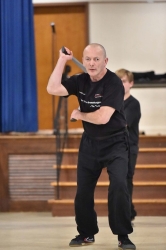
Whenever we think of the Filippino martial arts, the first thing that comes to mind is the stick, one of the weapons often used. We are all acquainted with the rhythmic click click click of stick on stick. The baston normally is 28” 26” or 24” 3/4-1inch in diameter. It may be longer depending on the type of Kali or Arnis training in, (Tapado is about 40” long and slightly thicker).
The baston basically can be divided into three parts, the puny or butt end, the main shaft, and the tip. The baston can be used in a variety of ways, basic striking with the shaft would be called a hammer strike and could be delivered from the tip or the main body of the shaft. The tip can be used in thrusting stabbing motion (buno) attacking the softer venerable targets of the body. The Punyo would be used for close range attacks as well as assisting in catching and disarming the opponents weapon. There is also the thrust and slash which is a combination of the bunny strike and the hammer strike. Some of the lesser known applications of the baston would be the double handed, Military Combat tactical, which is exactly as it sounds, using two hands at either end of the baston to engage the opponent. Also there is the reverse grip, turning the baston into a Tonfa like weapon PR-24, using many of the same offensive and defensive principles.
Next up we’ll be discussing the short blade, dagger. Knives are a mainstay in all cultures, some more than others. In the Philippines, the short blade is used as much as a household item as a martial arts weapon (try opening a can with one). The manipulation of the blade in all Kali and Dekiti Tirsia is what makes it unique. The first grip we’ll consider is the “complete grip”. This would be the grip you would use to cut your steak with. The thumb is usually tucked in as if you were going to punch with a fist. The first application of this grip would be the thrusting (sengetti, bunts) using the 12 strikes aiming for various target points on the body. The main reason for stabbing instead of slicing is for combat effectiveness.
The second grip most used is the Pakal or reverse grip. In Dekiti, it is primarily used with the blade facing in for use in a hooking fashion. If you’ve ever practiced praying mantis Kung Fu or have observed a praying mantis you can see the functionality of such a grip. This grip can be used for trapping and holding along with the redirection and cutting. The other variation of this grip would be the blade facing out, which would add a forward slicing into the mix. When using either of these grips, it is important to always be aware of the disposition of your own blade as well as your opponent.
The last weapon I’ll talk about today is the Karambit, perhaps my favorite short blade. Based on the tiger’s claw, the blade is rounded for grabbing and ripping, and has a ring at the top. Many of the styles of martial arts in South East Asia have the Karambit as part of their arsenal, most will deploy it with the finger in the ring. This is where Dekiti Tirsia differs. The Dekiti practitioner will never put his finger in the hole during combat. This is to assure the user of not losing a finger in the event of a disarm. Using the 12 strikes as a base, the techniques are endless. Single, double, and triple strikes are used in conjunction with targeted points on the body. Again the footwork is key especially when dealing with longer weapons.
Next time I will give you a brief view of the long bladed weapons (tailbone and Gununting), as well as a few that may surprise some.
- The Martial Effectiveness of Drills in Filipino Martial Arts (FMA) - February 5, 2025
- The Resurgence of Traditional Martial Arts in Modern Mixed Martial Arts - January 7, 2025
- The Night Christmas Almost Died - December 21, 2024

Leave a Reply